Energy is an essential part of American life and a staple of the world economy. The Trump Administration is committed to energy policies that lower costs for hardworking Americans and maximize the use of American resources, freeing us from dependence on foreign oil.
For too long, we’ve been held back by burdensome regulations on our energy industry. President Trump is committed to eliminating harmful and unnecessary policies such as the Climate Action Plan and the Waters of the U.S. rule. Lifting these restrictions will greatly help American workers, increasing wages by more than $30 billion over the next 7 years.
Sound energy policy begins with the recognition that we have vast untapped domestic energy reserves right here in America. The Trump Administration will embrace the shale oil and gas revolution to bring jobs and prosperity to millions of Americans. (does he have no understanding of energy market?) We must take advantage of the estimated $50 trillion in untapped shale, oil, and natural gas reserves, especially those on federal lands that the American people own. (does he not know the havoc in ND during Bakken BOOM!, the many Bakken BOOM! train explosions, pollution, and deaths? And he’d allow corporations to take OUR land?) We will use the revenues from energy production (a production tax increase?) to rebuild our roads, schools, bridges and public infrastructure. Less expensive energy will be a big boost to American agriculture, as well.
The Trump Administration is also committed to clean coal technology, and to reviving America’s coal industry, which has been hurting for too long. (again market forces, coal is not least cost, and new coal is way beyond anything market would support. “Clean” coal? Don’t even think about it, it doesn’t exist!)
In addition to being good for our economy, boosting domestic energy production is in America’s national security interest. President Trump is committed to achieving energy independence from the OPEC cartel and any nations hostile to our interests. At the same time, we will work with our Gulf allies to develop a positive energy relationship as part of our anti-terrorism strategy.
Lastly, our need for energy must go hand-in-hand with responsible stewardship of the environment. Protecting clean air and clean water, conserving our natural habitats, and preserving our natural reserves and resources will remain a high priority. President Trump will refocus the EPA on its essential mission of protecting our air and water. (everything I’ve seen and heard from Trump and EPA pick points towards dismantling and defunding EPA. What does this mean?)
A brighter future depends on energy policies that stimulate our economy, ensure our security, and protect our health. Under the Trump Administration’s energy policies, that future can become a reality.
Xcel’s new normal — 2016 year end earnings call
February 2nd, 2017
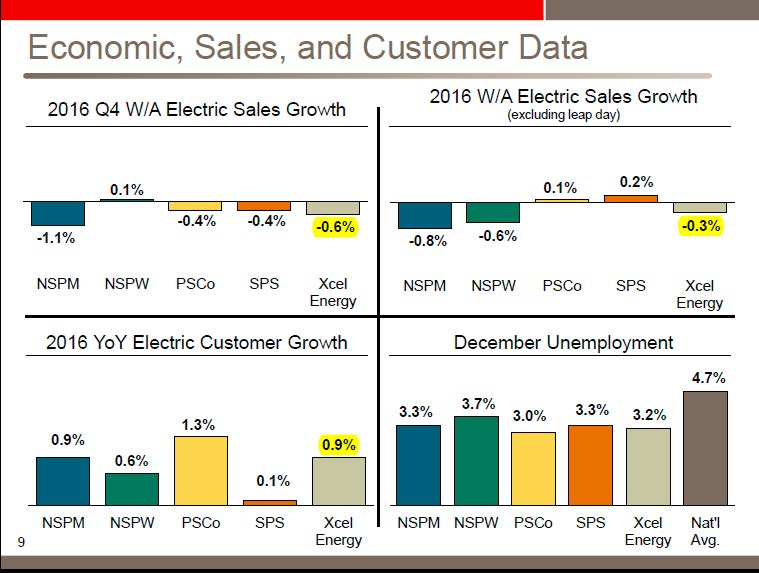
Xcel’s 2016 Earnings Call was this morning. Look at the above chart, pay close attention to the numbers I’ve highlighted in yellow. 2016 4th Quarter sales growth is down 0.6%. Yearly sales decrease is -0.3%. Here’s the rest of the Earnings Call Presentation:
Remember CapX 2020, based on projections of annual increases of 2.49%. Remember Commerce’s Steve Rakow who introduced the most bizarre chart ever in an effort to prop up need for CapX 2020, one without identifying the X axis or Y axis and just a sine wave trending sharply upward? Yea, this one…
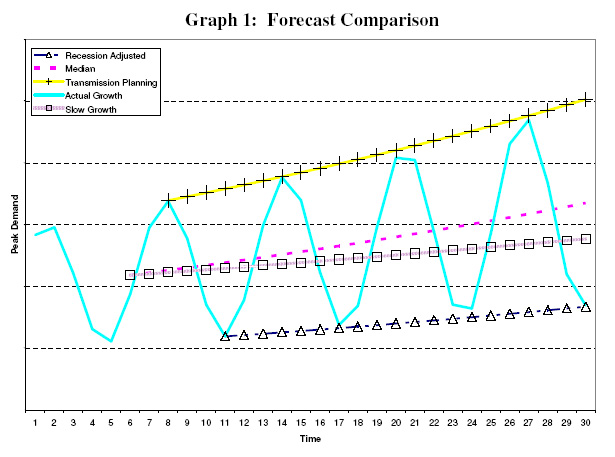
Hasn’t worked out that way, has it… the 2016 10-K isn’t filed yet, so there’s only 2015 to go on, though looking at their 10-Q for summer, I expect it’s flat at best.
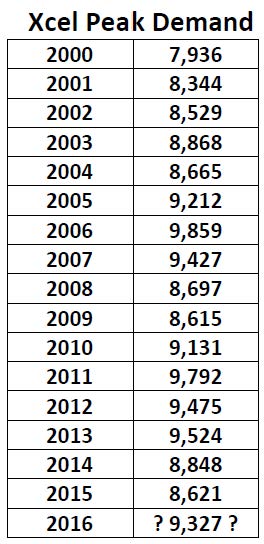
So with sales down, I presume it’ll be flat peak demand? It’s not disclosed in the 3rd Quarter 10-Q. Xcel, we’ll be looking for that this month in your 10-K filing!
tRump’s Memoranda & Executive Orders
January 24th, 2017

There’s been a flurry of activity, and finally they posted the actual documents so we can see what’s going on, or what won’t be going on. This was part of my “One a Day” plan to send off a missive to the White House every day, something of substance. When the Contact page was blank on Monday morning, I started calling, ALL DAY LONG, and got through around 7 p.m., when a human answered, and hung up. I called back, got that same human, who wouldn’t tell me who I should talk to about the Executive Orders (presumed that’s what they were as that’s what was said) and said the Comment office person was gone so I had to leave it online, and she got pissy when I said that the Comment page was blank, and hung up again. OK, whatever…
Civics Lesson from USA Today, Presidential memoranda vs. executive orders. What’s the difference?
Here are the Memoranda thus far from the White House page (these are not required to be published in the Federal Register, so ???, but they are now on the White House Memoranda page:
Presidential Memorandum on January 24, 2017Presidential Memorandum on January 24, 2017Presidential Memorandum on January 24, 2017Presidential Memorandum on January 24, 2017Presidential Memorandum on January 23, 2017Presidential Memorandum on January 23, 2017Presidential Memorandum on January 23, 2017Presidential Memorandum on January 20, 2017
And here are the Executive Orders, from the White House Executive Order page:
Executive Order on January 24, 2017Executive Order on January 20, 2017
Now maybe they’ll have the routine down and keep up with what they’re doing. Drives me crazy to be loating around in the dark — it’s hard enough to know or guess what these might mean in practice, but without an actual document to look at, it’s just blather. Well, it’s just blather anyway, but here it is. Read it and get busy!
An America First Energy Plan?
January 23rd, 2017

Contact Page for Trump’s White House
Comments: 202-456-1111
Switchboard: 202-456-1414
The Trump regime has published this “Energy Plan.” WHAT? Mitt Romney’s “Energy Plan” wasn’t much, and was grossly misguided, but it at least had SOME substance:
Romney’s Energy Plan – much ado about nothing
This is something a 5th grader could put together, nothing but blathering and slapped together code words. It shows no thought or understanding of energy in the U.S. today. I mean really, “clean coal” is so dead. During the Bush administration, they put billions in, between tax credits, grants, subsidies at state and federal levels — here’s a DOE announcement from 2006:
Energy Secretary and Secretary of the Treasury Announce the Award of $1 Billion in Tax Credits to Promote Clean Coal Power Generation and Gasification Technologies
The Bush Administration made coal gasification (IGCC) a priority, and even all that lobbying, subsidization, and wishful thinking couldn’t make it happen. Minnesota’s Excelsior Energy’s Mesaba Project is one example of that abject failure (see also www.camp-site.info). Delaware’s NRG coal gasification plant is another (note another NRG coal gasification plant proposed for NY went south too).
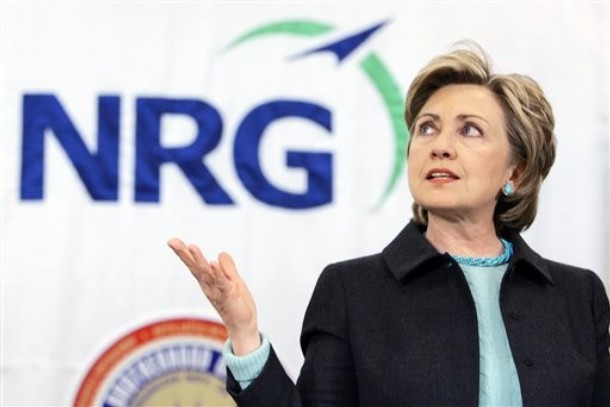
Meanwhile, existing coal is not economical, that’s why the older plants are being shut down, not anything to do with “Clean Power Plan,” and instead, that there’s a surplus of electricity and coal plants’ production costs a lot more than other available electric generation. The market says no! How does Trump think he can trump the market? And even if he could, how is that in our interest?
Here’s a map of MISO market — note all the blue on these maps — I love using these as wallpaper, a constant reminder:
Here’s the PJM market map:
And the joint MISO/PJM market map:
Coal cannot compete in the market, even with its outright and embedded regulatory subsidies, even the existing plants. There’s a glut of electricity, has been for a decade now. As Xcel’s Ben Fowkes says, recorded in the Seeking Alpha transcript of the XEL Earnings Call, January 31, 2013.
So…. drumroll…. Here it is, cut and pasted from the White House site in its entirety (emphasis added in red)(and parenthetical comments):
How clueless can Trump be? Well, we’re seeing… and it’s unbelievable… UNBELIEVABLE!
Drumpf’s “Questionnaire” to Dept. of Energy
December 9th, 2016
Trump’s energy agenda, vague as it is, has been essentially to promote “clean coal,” nuclear and to deny climate change and dismantle federal climate change and “renewable” energy programs, of course with no move to eliminate subsidies for coal and nuclear. The “transition team” sent a big laundry list of questions to the Department of Energy, and it’s pretty broad. It’s also something that would be both telling and intimidating to receive. Looking at this, there’s no doubt where they’re headed.
Here’s the document — read it and see what you think… and note how many of these questions are “Can you provide…” which are easily answered with just a “Yes” or “No” and that’s the end of it!
But wait… there’s another version (similar, but different order, etc.):
I think Trump needs somebody to write his questions for him, somebody new that is. He obviously didn’t come up with this, but his staff person who did, well, if they worked for me, “YOU’RE FIRED!”
NOTICE – Annual Hearing – Power Plant Siting Act
December 5th, 2016
Here we go again, the Annual Hearing for the Power Plant Siting Act.
The full Notice:
Now’s the time to dig back into the cobwebs of memory of all the dockets over the last year, and the last 20+ years, and let them know how the Power Plant Siting Act is working, and more importantly, how it’s not working.
Comments are open until January 20, 2017. To file in eDockets (highly recommended), go here, and log in. If you don’t have an account, register (it’s simple, and fast) and then file in docket 16-18.
Note something different, this year they’re going to go over pipeline projects:
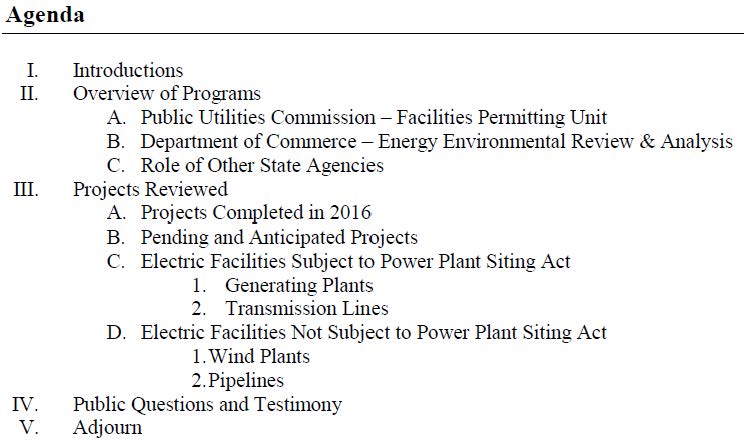 Recently, I’ve been involved in a project working toward increased meaningful and effective public participation in a pipeline docket, and what’s going through my head as I attend meetings, conference calls, and read very long intense emails, is that this is exactly what we’ve been talking about at these Power Plant Siting Act hearings for TWENTY YEARS! This is exactly what we’ve been working to deal with in the Certificate of Need Minn. Ch. 7849 rulemaking for THREE YEARS! These are exactly the same issues I’ve been raising in docket after docket, gaining a remand in one, some “adjustments” in others, and even to the appellate court a couple of times — MCEA had more success in this (see the EIS decision here). And so little changes.
Recently, I’ve been involved in a project working toward increased meaningful and effective public participation in a pipeline docket, and what’s going through my head as I attend meetings, conference calls, and read very long intense emails, is that this is exactly what we’ve been talking about at these Power Plant Siting Act hearings for TWENTY YEARS! This is exactly what we’ve been working to deal with in the Certificate of Need Minn. Ch. 7849 rulemaking for THREE YEARS! These are exactly the same issues I’ve been raising in docket after docket, gaining a remand in one, some “adjustments” in others, and even to the appellate court a couple of times — MCEA had more success in this (see the EIS decision here). And so little changes.
2006 Report to PUC – Docket 06-1733
2007 Report to PUC – Docket 07-1579
2008 Report to PUC – Docket 08-1426
2009 Report to PUC – Docket 09-1351
2010 Report to PUC – Docket 10-222
2011 Report to PUC – Docket 11-324
2012 Report to PUC – Docket 12-360
2013 Report to PUC – Docket 13-965
2014 Summary Comments– Docket 14-887
OK, folks, time to saddle up for another cattle drive! Let’s get to it!
And on December 20… sigh…


